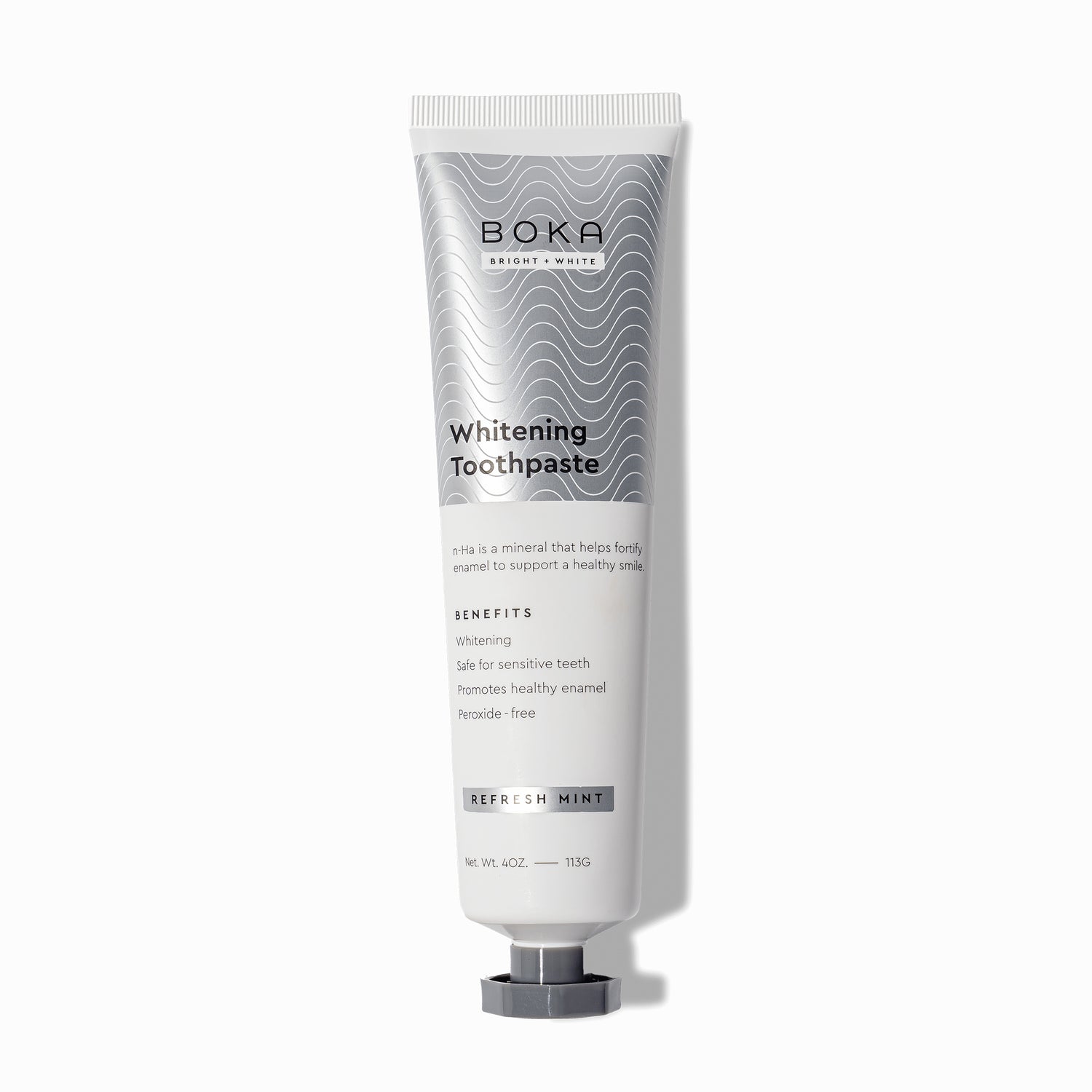Gleaming pearly whites is something we all want and plenty of businesses offer teeth whitening services to keep your teeth looking their best.
Far from just looking good, clean white teeth and a good dental hygiene routine will keep your teeth stronger for longer.
While teeth whitening services are a great way to get your teeth looking their best, you might wonder if the process is permanent.
So here’s the answer: No, teeth whitening is not permanent. The effects can last anywhere from a few months to up to three years, depending on several factors, such as the type of whitening, oral hygiene habits, and Individual factors.
Are there ways to extend the effect of your most recent cleaning and whitening? Yes, there are ways to extend the duration.
In this article, we’ll discuss how you can keep your teeth whiter for longer and other key features of dental health that can prevent staining and discoloration of your teeth.
Types of Teeth Whitening
Teeth whitening comes in several forms, from home-use whitening strips to professional whitening from a dentist.
Knowing what works best and how it works is key to getting the best out of your chosen teeth-whitening strategy.
In-Office Teeth Whitening
Professional teeth whitening is the top standard for getting your teeth shiny and bright!
Dentists and dental hygienist services that offer teeth whitening use a variety of techniques and technologies not easily accessible at home to lift stains and brighten up your teeth.
The most common form of in-office teeth whitening uses hydrogen peroxide or carbamide peroxide to lift stains.
Instead of simply scrubbing your teeth clean with paste, these chemicals are used to agitate stains on a molecular level, lifting them off without scrubbing the enamel or the tooth heavily.
This process is limited to dentists and other professionals because these chemicals need to be kept clear of the gums and other mouth tissue as they can burn them if they come into contact.
However, they are immensely effective in removing stains and whitening teeth.
Other processes involved in whitening your teeth at the dentist include gentle scrubbing with pumice gel to remove plaques, using fluoride to combat sensitivity, and of course, mouth rinsing.
In-office teeth whitening can be costly, depending on the dentist you go to and the number of applications you need to get your teeth gleaming white.
On top of this, regular upkeep is necessary to keep your teeth clean!
Using at-home whitening kits, especially those that use Phthalimido-Peroxy-Caproic Acid can be a great supplement to professional whitening.
At-Home Teeth Whitening
There are many at-home teeth whitening systems on the market today that can each claim different pros and cons.
While these systems are generally not as effective in a single application as professional teeth whitening, they can be very effective after repeated uses! Choosing the right method to whiten your teeth at home can help extend the time between dental visits for professional whitening.
Whitening Toothpaste
One of the most popular and readily available means of whitening teeth at home is whitening toothpaste.
Whitening toothpaste functions by using mild abrasives in the toothpaste to buff out stains before they set in too deeply.
If you’re looking for a whitening toothpaste, the best option is to opt for a gentler toothpaste, one that doesn’t include irritating chemicals like peroxide!
Whitening toothpastes that focus on gentle and naturally whitening ingredients like baking soda and nano-Hydroxyapatite can help improve the whiteness of teeth over time.
Although it requires regular use to be effective, it’s effective in maintaining the whiteness provided by professional whitening!
It could take two to six weeks to see any benefits if you use whitening toothpaste twice a day. According to users, these effects can last longer for three or four months.
Too much whitening toothpaste over time might weaken tooth enamel. If you want to use whitening toothpaste for a long time, consider switching it up with toothpaste that strengthens and protects enamel. Try Boka toothpaste…
Whitening Strips
Another popular whitening method is whitening strips. Whitening strips are placed against the surface of the teeth and left adhered for 30 minutes or more to whiten stains from the front of your teeth.
Commonly available whitening strips often dilute hydrogen peroxide to bleach surface stains to the appropriate whiteness.
These days, newer whitening strips use gentler chemicals to prevent tooth or gum irritation without foregoing the whitening we all desire.
Whitening strips should be used daily for seven days to create gradual whitening but the results can last for months!
The number of treatments required with whitening strips before you see results varies. Certain strips offer better outcomes that can persist for up to six months.
Whitening Pens
Whitening pens are another popular method of keeping teeth clean and shiny.
Whitening pens also contain either hydrogen peroxide or carbamide peroxide which is used to break stains into small pieces and bleach them white.
Whitening pens that avoid harsh chemicals are safer as there is no risk of irritating gums or teeth.
With gentler yet fortifying chemicals, these can be more effective in maintaining teeth whiteness. Plus their pocket-size convenience makes touch-ups and whitening makeovers easier even on the go!
Whitening Kits
Whitening kits are a more high-tech means of home whitening, using UV-activated gel to whiten teeth in a process closest to that which you might get at a dentist.
Whitening kits use enamel-safe whitener that targets and eliminates compounds that cause teeth discoloration.
With regular use, home whitening kits can maintain whiter teeth and offer longer-lasting results than any home remedies.
Natural Remedies
There are many natural teeth whitening remedies from all over the world and they all work to varying degrees, or at least are harmless enough to be worth a try.
The most common of these is using baking soda to whiten teeth. Baking soda is a mild abrasive that can buff out stains from your teeth with regular use. While brushing with solely baking soda is not a very appealing prospect, using toothpaste that includes baking soda can have real positive results.
Other natural remedies, like oil pulling, are not scientifically proven to have any major benefits for teeth whitening, so it’s best to use the appropriate over-the-counter toothpaste or whitening kits to see results.
Factors that Influence Teeth Whitening
Other than getting your teeth whitened by a professional or using at-home whitening tools to improve the color of your teeth, other factors can help your teeth stay white such as Diet and lifestyle, genetics, and age.
Diet and Lifestyle
One of the most immediately obvious factors influencing teeth whiteness is diet and lifestyle.
Food heavy in natural pigments like beetroot and berries can stain teeth due to their natural pigment.
Acidic foods and drinks can also damage the tooth’s enamel, which makes your teeth less able to deal with stains and general health.
Anybody who want to maintain white teeth must abstain from or use less of foods and beverages like red wine, tea, and coffee that can discolour teeth.
Further, poor dental routines and things like smoking, vaping, and drinking coffee can create stains themselves.
Nicotine in particular creates heavy staining on the front teeth where the smoke of vapour flows.
Tobacco products and smoking are among the worst things that may happen to a once-bright smile. The stain is caused by nicotine, which is found in tobacco products. To preserve teeth and dental health, it is imperative to break the practice.
Oral Hygiene
Oral hygiene naturally plays a role in teeth witness. Regular brushing, flossing, and mouthwash are all important in removing debris and stains from food and drink before they settle in.
Gentle products, that use nano-hydroxyapatite don’t damage the tooth enamel and so keep your teeth strong and healthy, as well as fortifying them against further staining in the future.
Flossing and mouthwash help maintain overall oral health.
It is imperative for anyone seeking to prolong the effects of a professional teeth-whitening procedure to maintain proper dental hygiene.
This entails using an antiseptic mouthwash to eliminate bacteria that cause plaque, flossing once a day to get rid of plaque in hard-to-reach areas, and cleaning their teeth at least twice a day.
Touch-up Treatments
Touch-up treatments are an important step in maintaining the whiteness of your teeth from a professional whitening or home remedy.
Whichever path you take, consistent touch-ups help to keep your teeth white without requiring a whole new trip to the dentist!
Age and genetics
Age and genetics play an important role in dental health and teeth whiteness.
For instance, the thickness of your dental enamel is a genetic trait that can be inherited from your parents, so thinner enamel is less likely to repel staining leading to discolored teeth.
There are plenty of genetic conditions that can be inherited that will affect the whiteness of your teeth, such as Dentinogenesis Imperfecta, which creates greyer more translucent teeth.
The best way to manage genetic issues with teeth whiteness is to maintain an effective dental hygiene schedule.
Age also plays a factor! As we age, the enamel in our teeth naturally weakens.
Age comes with a general deterioration of the body’s systems, and teeth are no different. Again, the best remedy is good oral hygiene practices.
Existing Dental Work
Dental work can change the whiteness of your teeth as dental replacements don’t have enamel and will not respond to any whitening agents.
This means that as false teeth or invisible fillings age and discolor, there is no way to whiten them without replacing them. Regular cleaning as part of good oral hygiene can help slow this process.

